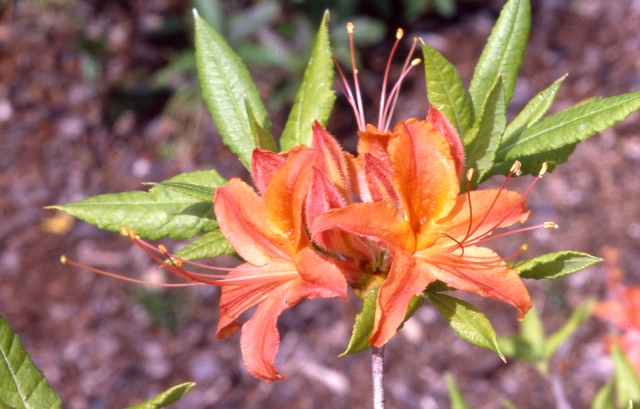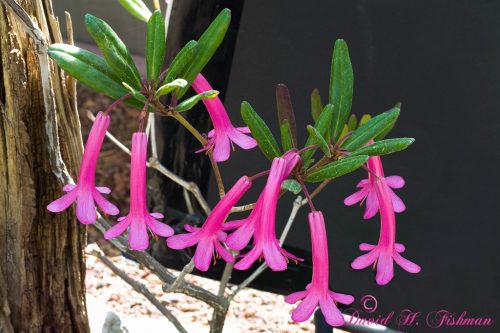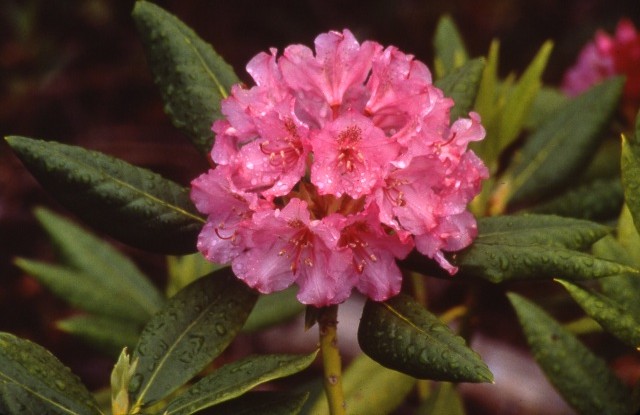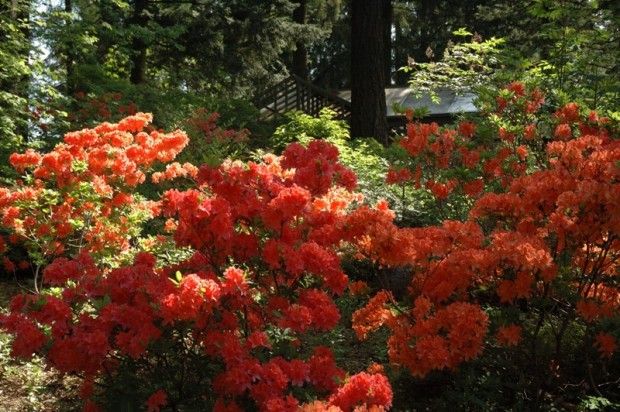
There are more than 1200 different natural species in the Genus (group) Rhododendron. These wild types, called species (as differentiated from hybrids), are native to the temperate regions of Asia, North America, and Europe, as well as to the tropical regions of southeast Asia and northern Australia. No Rhododendron species are indigenous to Africa or South America. By far, the largest number of wild species rhododendrons are native to Asia. Wild rhododendrons are found from sea level to 16,000 feet in elevation, and they occur in a variety of habitats, including alpine regions, coniferous and broadleaved woodlands, temperate rain forests, and even tropical jungle conditions.
Rhododendrons exhibit an enormous diversity of size and shape, from prostrate ground covers growing no more than a few inches high to trees more than 100 feet tall. Between the prostrate alpine forms and large trees are a variety of shrubby forms in all shapes and sizes. Leaf sizes range from less than 1/4 inch to almost three feet long, and they also appear in a variety of shapes: rounded, lance-shaped, and elliptical. The flowers may be white, red, pink, yellow, almost blue, purple, magenta, orange, and shades and mixtures of most of these colors. There is diversity, too, in bark texture and color. And while March, April, and May represent the peak months for flowering, some rhododendrons can flower as early as January in an ideal climate and others as late as October. The actual beauty of many is supreme -in flower, in decorative new growth, in foliage, in bark, in structure, and even in fall color, the latter is noted particularly with deciduous azaleas.

Rhododendrons, not surprisingly, are among the most popular shrubs that people grow where conditions are suitable. They grow best in climates that avoid extremes in temperature and have substantial rainfall. They also require a slightly acid soil. Hence, the western coast of Britain and Scotland and the coastal Pacific Northwest of North America have close to ideal conditions. In the Pacific Northwest the rhododendron is ubiquitous in both public and private gardens. Indeed, because the winter weather west of the Cascade Mountains is relatively mild, the blooming season is often quite long at the Rhododendron Species Botanical Garden, where flowers of a few species often begin to appear in early January. The majority bloom from March through May with a smaller number of species flowering in June and July. One of the very last species to flower is called Rhododendron faithiae and is especially attractive with its large white trumpet flowers in late September which are fragrant! The last azalea to flower is Rhododendron prunifolium, with salmon-red flowers opening in late June or July.

The state flower of Washington is the Pacific rhododendron, R. macrophyllum, which means “rose tree with large leaves.” Rhododendron macrophyllum grows in the wild from British Columbia, Canada to central coastal California. Its flowers are typically various shades of pink and mauve, with the occasional white.
Most of the rhododendrons people grow are hybrids, rather than natural species. Rhododendron species as found in the wild grow, flower, are pollinated, and set seed. The seedlings are usually pollinated by the plants of the same species and generally look similar to the parent plants, though there may be small, and sometimes considerable, variations among them. But they remain the same species. For example, a plant belonging to the species R. macrophyllum is pollinated by another plant of R. macrophyllum. The resulting offspring are also R. macrophyllum, though the shade of color, for instance, may be different from that of either parent.

Hybrid rhododendrons, on the other hand, are plants resulting from the cross-pollination of one species with a different species or hybrid. When this happens the offspring may look quite different from either parent. For example, when pollen is taken from a plant of R. macrophyllum, (Pacific rhododendron) and used to pollinate another species of rhododendron, such as R. catawbiense, the Catawba rhododendron native to the east coast of the United States, the seedlings will have characteristics of both parents mixed together. Sometimes when two or more species occur in near proximity to each other in the wild and flower at the same time, nature will do the cross pollinating to produce what are called ‘natural’ hybrids. But people have been artificially creating hybrid rhododendrons for many years, by hand pollinating one species or hybrid with the pollen from another, and there are now tens of thousands of hybrid rhododendrons. Instead of the Latin names given to natural species, hybrids are named in the vernacular, such as ‘The Honorable Jean Marie de Montague,’ ‘Pink Pearl,’ ‘Cynthia,’ ‘Unique,’ and ‘Purple Splendour.’ The purposes for hybridizing can be various: larger flowers, different forms with different colors, larger flowers that are more cold or heat tolerant, etc. Many are very beautiful, but most appear, to species enthusiasts at least, to lack the elegance and natural beauty of the species themselves.

Azaleas are also rhododendrons. The group of plants commonly called azaleas are actually classified by botanists as belonging to the Genus Rhododendron and the name for each type of azalea has both the word “Rhododendron” and the species name, just as with other rhododendrons. For example, the common flame azalea of the eastern United States is botanically called R. calendulaceum. Azaleas can be either deciduous (meaning they lose their leaves in the autumn), evergreen, or semi-evergreen. Semi-evergreen means that the azalea may lose some but retain most of their leaves throughout the winter. (It should be noted, in fact, that other rhododendrons can also fall into these different categories; R. mucronulatum, for instance, is completely deciduous, but this is a rare exception among them.) Deciduous azaleas are native to the eastern and western areas of the United States and Canada, Japan, China, and scattered locations across eastern Europe. Evergreen azaleas are found only in central-eastern and southeastern Asia. Hybridizers have made innumerable crosses among the azaleas, as they have among other rhododendrons, and there are thousands of hybrids. Azaleas can be more heat tolerant than many other rhododendrons and are particularly popular in hot places, like the American southeast and the cities of Japan.
